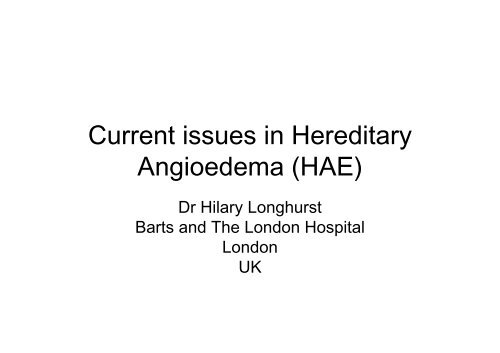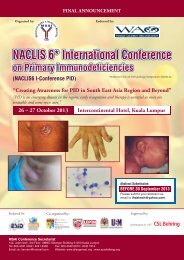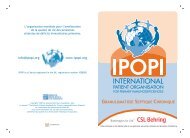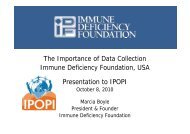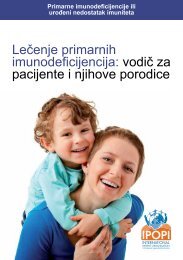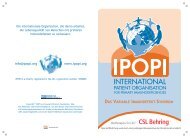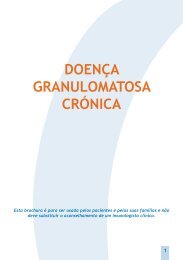Current issues in Hereditary Angioedema (HAE) - Ipopi
Current issues in Hereditary Angioedema (HAE) - Ipopi
Current issues in Hereditary Angioedema (HAE) - Ipopi
You also want an ePaper? Increase the reach of your titles
YUMPU automatically turns print PDFs into web optimized ePapers that Google loves.
<strong>Current</strong> <strong>issues</strong> <strong>in</strong> <strong>Hereditary</strong><br />
<strong>Angioedema</strong> (<strong>HAE</strong>)<br />
Dr Hilary Longhurst<br />
Barts and The London Hospital<br />
London<br />
UK
<strong>Current</strong> <strong>issues</strong> <strong>in</strong> <strong>HAE</strong><br />
• Overview of <strong>HAE</strong><br />
• New/ newly licensed drugs<br />
– C1 <strong>in</strong>hibitor (Ber<strong>in</strong>ert, Cetor, C<strong>in</strong>ryze)<br />
– Recomb<strong>in</strong>ant C1 <strong>in</strong>hibitor (Rhuc<strong>in</strong>)<br />
– Icatibant (Firazyr)<br />
– Ecallantide (DX88; Kalbitor)<br />
• Rational use of preventatıve medıcatıon<br />
– Danazol/ stanozolol/ oxandrolone<br />
• General <strong>issues</strong>
What is <strong>HAE</strong> (<strong>Hereditary</strong><br />
• <strong>HAE</strong> 1 or 2<br />
.. Lack of C1 <strong>in</strong>hibitor<br />
prote<strong>in</strong><br />
angioedema)<br />
• <strong>HAE</strong> 3<br />
..similar symptoms but<br />
not C1 <strong>in</strong>hibitor deficiency<br />
• AAE (acquired<br />
angioedema)<br />
– Lack of C1 <strong>in</strong>hibitor<br />
develop<strong>in</strong>g <strong>in</strong> later life
<strong>HAE</strong>- C1 ınhıbıtor defıcıency<br />
• Swellıngs of<br />
hands/ feet /<br />
face/other areas<br />
• Swellıngs of<br />
ıntestıne<br />
‘abdomınal<br />
attacks’<br />
• Swellıngs of<br />
larynx/throat
C1 <strong>in</strong>hibitor controls <strong>in</strong>flammation<br />
• Complement<br />
• Bradyk<strong>in</strong><strong>in</strong><br />
• Clott<strong>in</strong>g/ anticlott<strong>in</strong>g
Prevention vs treatment<br />
Prevention (prophylaxis)<br />
Treatment<br />
•C1 <strong>in</strong>hibitor (‘Ber<strong>in</strong>ert’,<br />
‘Cetor/C<strong>in</strong>ryze’)<br />
•Icatibant (‘Firazyr’)<br />
•(Ecallantide/ ‘Kalbitor’)<br />
•(Recomb<strong>in</strong>ant C1<br />
<strong>in</strong>hibitor ‘Ruconest’)<br />
– Danazol/stanozolol/<br />
oxandrolone “attenuated<br />
androgens”<br />
– Tranexamic acid<br />
Tablets<br />
Injections
What have we learnt about the new<br />
• C1 <strong>in</strong>hibitor (Ber<strong>in</strong>ert)<br />
treatments<br />
We need to use a higher dose- 3 vials for an<br />
average sized person<br />
25 kg 4 st 1 vial (500 units)<br />
50kg 8 st 2 vials (1000 units)<br />
75 Kg 12 st 3 vials (1500 units)<br />
100 kg 16 stone 4 vials (2000 units)
C1 <strong>in</strong>hibitor- dosage <strong>issues</strong><br />
Mrs A 33 yrs<br />
• 8 years – hand/ feet swell<strong>in</strong>gs<br />
• 3 facial swell<strong>in</strong>gs<br />
– 2003- 7 days <strong>in</strong> hospital<br />
– 2009- 4 days <strong>in</strong> hospital, laryngeal obstruction<br />
– 2010- associated with abdom<strong>in</strong>al pa<strong>in</strong>,<br />
vomit<strong>in</strong>g<br />
• Treated on day 3 with 500 units C1 <strong>in</strong>hibitor<br />
• Resolution after 4 further days
• Ber<strong>in</strong>ert (C1 <strong>in</strong>hibitor)<br />
trials<br />
– 20 U/kg (ie at least 3 vials)<br />
– Much quicker response<br />
and recovery at this dose<br />
– Recommend this dose for<br />
most people<br />
– esp. extensive, established<br />
or laryngeal attacks<br />
– [May be able to use lower<br />
doses for self<br />
adm<strong>in</strong>istration, or v<br />
t<strong>in</strong>y/early swell<strong>in</strong>gs]
• C<strong>in</strong>ryze (C1 ınhıbıtor) acute trials<br />
– 1000 units with second 1000 U dose after 1<br />
hour<br />
– Not equivalent to 2000 units up front<br />
– Recommended dose 2000 units
Treatment of C1 <strong>in</strong>hibitor deficiency<br />
-Rhuc<strong>in</strong>/Ruconest<br />
• Recomb<strong>in</strong>ant C1 <strong>in</strong>hibitor<br />
– Not blood product<br />
• Higher dose possible<br />
– 50U/ kg c.f. 20U/kg with Ber<strong>in</strong>ert<br />
• Purified from rabbit milk<br />
– Anaphylaxis <strong>in</strong> one severely rabbit allergic ‘normal’ volunteer<br />
– Otherwise v well tolerated<br />
– No significant antibody production<br />
• Short half life
Icatibant (Firazyr)<br />
• Subcutaneous bradyk<strong>in</strong><strong>in</strong> <strong>in</strong>hibitor<br />
– Local pa<strong>in</strong> & swell<strong>in</strong>g ‘giant bee-st<strong>in</strong>g’<br />
– Almost anyone can learn<br />
– Risks: large swell<strong>in</strong>g, patient with frequent attacks<br />
• Ideal for self adm<strong>in</strong>istration<br />
• Speed of onset of relief and resolution broadly equivalent<br />
to C1 <strong>in</strong>hibitor<br />
t=0 m<strong>in</strong> t=30 m<strong>in</strong>
Icatibant (Firazyr)<br />
• Recurrent attacks<br />
– Usually slow onset<br />
– May occasionally be fast<br />
– 10% need retreatment<br />
• Risk of recurrence <strong>in</strong>creased if:<br />
– Large swell<strong>in</strong>g/severe attack<br />
– Late <strong>in</strong> course of attack<br />
– Very frequent attacks (>1/week)<br />
Always have second syr<strong>in</strong>ge available- will be effective
Liv<strong>in</strong>g with hereditary angioedema:<br />
L’s story<br />
• 2002 17 years<br />
– Weekly swell<strong>in</strong>gs- ma<strong>in</strong>ly peripheral<br />
– Tranexamic acid 2g od- bd some help<br />
– Start<strong>in</strong>g first job<br />
• 2003<br />
– Reduced hours at work because of frequent <strong>HAE</strong>-related symptoms: low mood<br />
– Treatment of severe abdom<strong>in</strong>al attacks <strong>in</strong> hospital<br />
– Unwill<strong>in</strong>g to take attenuated androgens because of fear of virilisation<br />
– Difficulties with employer- ask<strong>in</strong>g about sickness benefits<br />
• 2004<br />
– New job at Marks & Spencer’s (M&S ‘Brita<strong>in</strong>’s favourite department store’)<br />
– Less stressful: no attacks <strong>in</strong> 3 months after start<strong>in</strong>g work<br />
– 1 st attack for 3 months- swell<strong>in</strong>g of hands, feet and abdomen- didn’t seek hospital care<br />
– 1 day off work<br />
– M&S policy: After 3 days off work, employee receives verbal warn<strong>in</strong>g. Dismissal possible for<br />
repeated time off.
Liv<strong>in</strong>g with hereditary angioedema:<br />
L’s story<br />
• 2005<br />
– Severe abdom<strong>in</strong>al attack – treated <strong>in</strong> hospital. Delay <strong>in</strong> receiv<strong>in</strong>g<br />
treatment, poor response, patient admitted overnight.<br />
– ‘Mild angioedema’ affect<strong>in</strong>g arms, legs, abdomen or neckuntreated<br />
– PCT consider<strong>in</strong>g fund<strong>in</strong>g C1 <strong>in</strong>hibitor for L to hold at home.<br />
• 2006<br />
– Facial angioedema, New Year’s Eve. Treated <strong>in</strong> hospital with C1<br />
<strong>in</strong>hibitor<br />
– No other attacks<br />
– Work<strong>in</strong>g <strong>in</strong> car showroom
Liv<strong>in</strong>g with hereditary angioedema:<br />
L’s story<br />
• 2008<br />
– Severe abdom<strong>in</strong>al attacks 4 times per year. Treated <strong>in</strong> A&E- but<br />
delays are common. Peripheral attacks monthly.<br />
– Home C1 <strong>in</strong>hibitor tra<strong>in</strong><strong>in</strong>g recommended.<br />
– Work<strong>in</strong>g part time<br />
• 2008<br />
– Pregnant, stopped tranexamic acid. 3 attacks requir<strong>in</strong>g hospital<br />
treatment <strong>in</strong> 9 weeks.<br />
– C1 <strong>in</strong>hibitor prophylaxis discussed but not implemented. Early<br />
maternity leave.<br />
• 2009<br />
– 6 days off work <strong>in</strong> 6 months- lost job, look<strong>in</strong>g for work
L’s story: 25 year old with <strong>HAE</strong><br />
• 2010<br />
– Ma<strong>in</strong>ly abdom<strong>in</strong>al attacks, every 2-3 weeks<br />
– Last 3-4 days<br />
– Severe abdom<strong>in</strong>al pa<strong>in</strong>, distension, vomit<strong>in</strong>g,<br />
fa<strong>in</strong>tness and sometimes loss of consciousness.<br />
– Followed by severe fatigue<br />
– Unable to do household duties for 3-4 days<br />
– Husband, mother or father need to take a day off<br />
work to care for L and her baby on day when<br />
symptoms are worst.<br />
• 3-4 hospital attendances only<br />
• Look<strong>in</strong>g for work
L’s story<br />
•2 nd March 2010<br />
– Severe abdom<strong>in</strong>al pa<strong>in</strong> & vomit<strong>in</strong>g<br />
– Symptoms had started 2 days previously, not<br />
improv<strong>in</strong>g<br />
– Given icatibant 30mg sc<br />
– Symptoms started to improve with<strong>in</strong> 30 m<strong>in</strong>s<br />
– Discharged after 2 hours<br />
– Fully recovered by the next day
L’s story<br />
•15 th March 2010- 2 weeks later….<br />
– Awoke with severe abdom<strong>in</strong>al pa<strong>in</strong>.<br />
– Self adm<strong>in</strong>istered backup icatibant<br />
– Similarly good response- but at onset of<br />
attack<br />
– Able to get up and resume normal duties<br />
– Husband amazed<br />
– ‘Like magic’ ‘life chang<strong>in</strong>g’
Treatment of C1 <strong>in</strong>hibitor deficiency<br />
-icatibant (Firazyr)<br />
Mean VAS scores vs. time for the primary symptom<br />
Mean VAS [mm]<br />
100<br />
90<br />
80<br />
70<br />
60<br />
50<br />
40<br />
30<br />
20<br />
10<br />
0<br />
Icatibant (JE049 #2102)<br />
Tranexamic acid<br />
Icatibant (JE049 #2103)<br />
Placebo<br />
0 1 2 3 4 5 6 7 8 9 10 11 12<br />
Time po<strong>in</strong>t [h]
Treatment of C1 <strong>in</strong>hibitor deficiency<br />
-ecallantide (DX88; Kalbitor)<br />
• Effectıve<br />
• Subcutaneous<br />
– Kallikre<strong>in</strong> <strong>in</strong>hibitor<br />
– Produced <strong>in</strong> pichia pastoris (recomb<strong>in</strong>ant<br />
prote<strong>in</strong>)<br />
• Short half life<br />
– 2 hours<br />
Avaılable ın USA
‘Acute dos<strong>in</strong>g reactions’-ecallantide<br />
(DX88; Kalbitor)<br />
• 8 reports of anaphylactoid reactions (~514 treatments)<br />
– May occur dur<strong>in</strong>g first treatment<br />
– Rh<strong>in</strong>itis, sneez<strong>in</strong>g, itchy throat, laryngeal oedema, hypotension<br />
– Some treated with adrenal<strong>in</strong>e etc.<br />
• Cause uncerta<strong>in</strong><br />
– No relation of antibodies to risk of reactions<br />
• 3 antiecallantide/7 anti-pichia (1 IgE)/1 antiecallantide & -pichia antibodies (8% of<br />
180 patients tested)<br />
– ‘Desensitisation’ <strong>in</strong> 6 of 8 patients-successful <strong>in</strong> 5<br />
FDA recommends not to be used for self adm<strong>in</strong>istration<br />
Schneider JACI 2007; Zuraw Expert op<strong>in</strong>ion <strong>in</strong>vest<br />
drugs 2008; Caballero, personal communication<br />
2005
Self adm<strong>in</strong>istration<br />
C1 ınhıbıtor or ıcatıbant<br />
• Access to acute treatment (via<br />
self adm<strong>in</strong>)<br />
– estimate ~95% attacks treated<br />
– Freedom from symptoms<br />
achievable<br />
– ‘political’ difficulties<br />
• No rapid access to acute<br />
treatment<br />
– Estimate ~ 5-25% attacks<br />
treated<br />
– Acceptance<br />
– unpredictable reversible<br />
disability<br />
– Loss of opportunity<br />
– ‘Blight’ on life
Prophylaxis: C1 <strong>in</strong>hibitor
C1 <strong>in</strong>hibitor controls local<br />
Healthy <strong>HAE</strong><br />
Inflammatory <strong>HAE</strong><br />
<strong>in</strong>flammation<br />
‘Inflammatory’<br />
non <strong>HAE</strong><br />
Healthy non-<strong>HAE</strong><br />
Control of local oedema<br />
Local C1 <strong>in</strong>hibitor function
Steroids<br />
• Naturally occurrıng steroıds:<br />
–Cortısol<br />
– Oestrogen/Progesterone/Testosterone<br />
•Steroıd medıcatıons<br />
– Attenuated androgens/Anabolic steroids<br />
• E.g. Danazol, stanozolol, oxandrolone<br />
– Prednisolone (taken for asthma, some forms<br />
of arthritis etc)
Rational use of steroids….
Mr B 15 yrs<br />
• Swell<strong>in</strong>gs once/ month- usually abdom<strong>in</strong>al<br />
– 1 day off school<br />
– 2-3 days ‘under the weather’<br />
– FFP at local hospital once/ month<br />
• Tranexamic acid 500mg twice daily<br />
– Slight reduction <strong>in</strong> severity & frequency of attacks<br />
• GCSEs com<strong>in</strong>g up<br />
Grandfather and great-grandfather died of <strong>HAE</strong>
Mr B 15 years<br />
• Unwill<strong>in</strong>g to tra<strong>in</strong> for C1 <strong>in</strong>h self-adm<strong>in</strong><br />
• Danazol 200mg daily on temporary basis<br />
over exams
Mrs B 45 years<br />
• Swell<strong>in</strong>gs once/ month- usually abdom<strong>in</strong>al<br />
• Some facial swell<strong>in</strong>gs<br />
• 2 days off school<br />
• 2-3 days ‘under the weather’<br />
• FFP at local hospital once/ month<br />
– Prodromal rash/ fatigue<br />
• Tranexamic acid 500mg twice daily<br />
– Slight reduction <strong>in</strong> severity & frequency of<br />
attacks
Mrs B 42 years<br />
• Danazol 100 mg at prodromal symptoms<br />
– One or two doses prevent attack<br />
– Initially danazol needed every month- now<br />
virtually never<br />
• C1 <strong>in</strong>hibitor for acute attacks <strong>in</strong> hospital:<br />
– 1 /year
Rational use of androgens<br />
• Better guidel<strong>in</strong>es*<br />
• Low dose<br />
– Max. 200mg danazol daily, 4 mg stanozolol<br />
• Alternatives to danazol<br />
– Stanozolol, oxandrolone, (tibolone)<br />
• Intermittent usage/ self management<br />
Life transform<strong>in</strong>g<br />
(Still need acute treatment)<br />
*2010 International consensus algorithm for the<br />
diagnosis, therapy and management of hereditary<br />
angioedema http://www.aacijournal.com/content/6/1/24
Need to control acute attacks
Poorer nations/ patients without<br />
<strong>in</strong>surance<br />
• Access to (diagnosis &) treatment<br />
– Oral prophylaxis<br />
–Acute<br />
• ‘recycl<strong>in</strong>g’ of expired treatments<br />
• Companies –access programmes<br />
• Post trial participants<br />
–Patıent representation for emerg<strong>in</strong>g nations
What does everyone want<br />
• Patients<br />
– Freedom from symptoms<br />
– Ability to prevent & treat<br />
attacks<br />
– Avoid side effects<br />
• Companies<br />
– Profit<br />
• Effective drugs<br />
• M<strong>in</strong>imal side effects<br />
• Drug better than<br />
competitors<br />
– Welfare of patients<br />
• Doctors<br />
– Healthcare/welfare of patients<br />
(and society)<br />
– Good <strong>in</strong>come<br />
– Status<br />
– Time with family<br />
– Freedom from adm<strong>in</strong>istrative<br />
hassle<br />
– Paternalistic/partnership<br />
• Fund<strong>in</strong>g authorities<br />
– Rema<strong>in</strong> with<strong>in</strong> budget<br />
– Make a ‘surplus’/ ‘profit’<br />
– Welfare of patients
Work<strong>in</strong>g with…<br />
•Doctors<br />
– Attitudes<br />
– Consensus documents<br />
• Pharmaceutical companies<br />
–Trıals<br />
– Access programmes<br />
• Publicity<br />
– <strong>HAE</strong>- personal stories- lay press<br />
– Medical publications/ conferences
Recent <strong>in</strong>itiatives<br />
• World consensus document published July 2010<br />
– Earlier treatment of acute attacks<br />
– New treatments<br />
• C1 <strong>in</strong>hibitor, icatibant, ecallantide<br />
– FFP (plasma) obsolete<br />
– Lower doses of danazol/stanozolol<br />
– Self adm<strong>in</strong>istration available for everyone who wants it<br />
– http://www.aacijournal.com/content/6/1/22 or 24<br />
• Trials of self-adm<strong>in</strong>istration of icatibant<br />
• Subcutaneous C1 <strong>in</strong>hibitor<br />
• Higher doses of C1 <strong>in</strong>hibitor<br />
• rC1 <strong>in</strong>hibitor for Europe-early 2011<br />
• Ecallantide for Europe- 2011<br />
• USA patient-led database<br />
• Icatibant outcome survey


